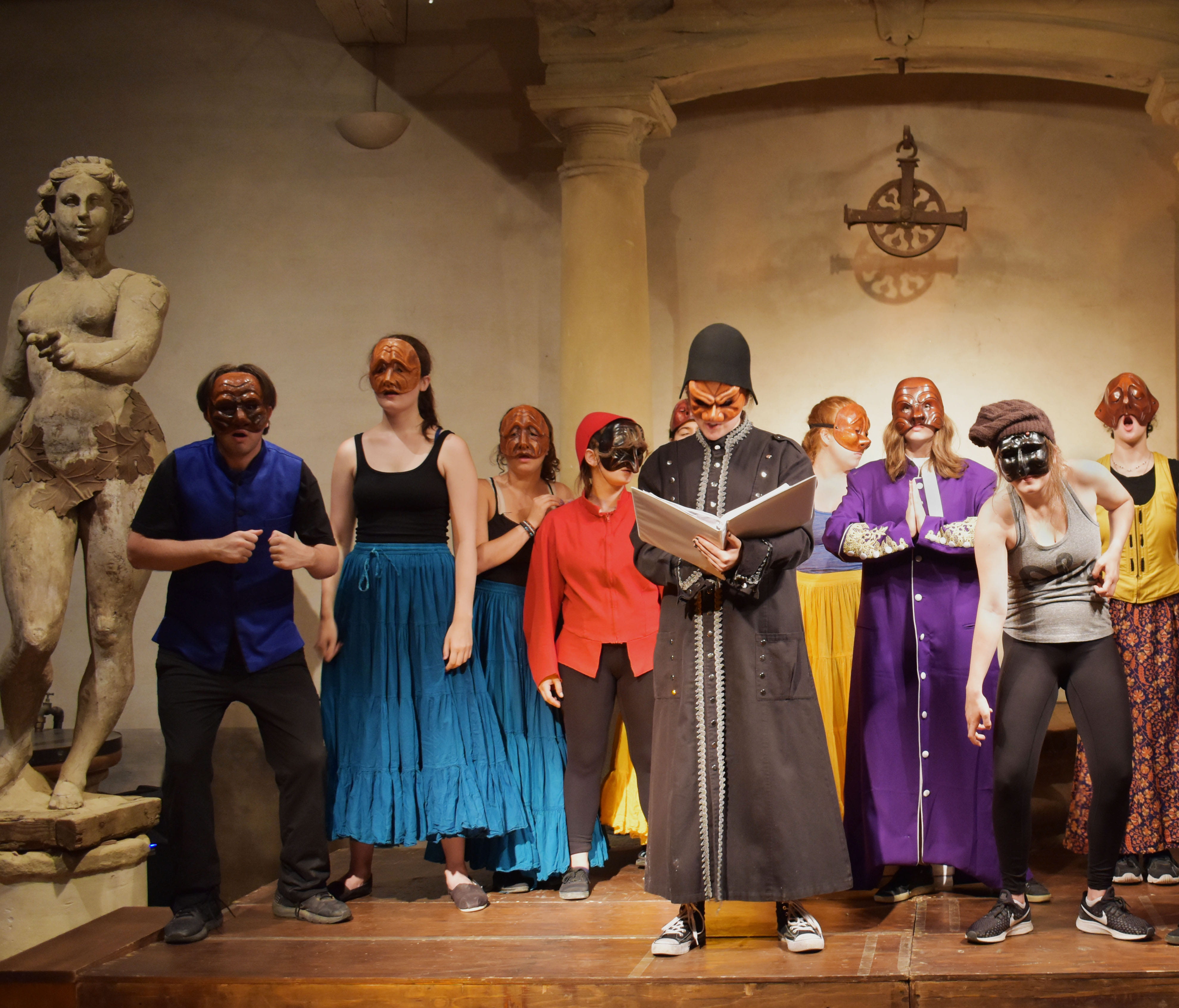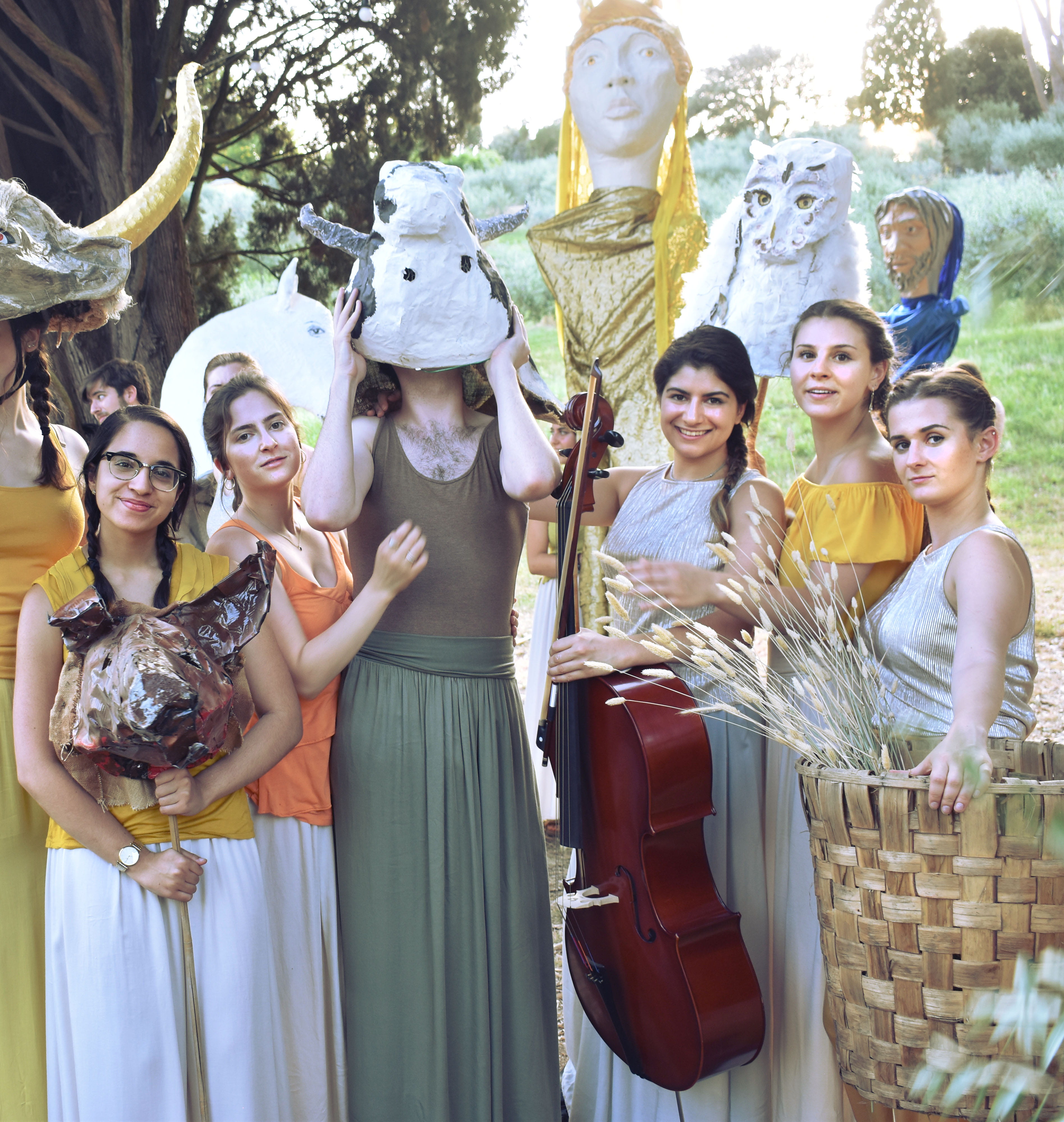Enlarge

Devin Shaket
“It was enlightening to do work with Commedia dell’Arte, a centuries old style of performance, and then use it as a pathway to help us grow as actors in the modern world,” says Ian LoCascio, a rising senior, Tisch School of the Arts, of his experience studying this summer at NYU Florence. Having toured with a Commedia group early in his career, James Calder, head of movement, Tisch Graduate Acting Department, and founder of the Commedia in Florence program, created a forum for learning the inventive theatrical form in its birthplace.
With a long and rich cultural heritage, Commedia dell’Arte (comedy of professional players), is an Italian theatrical tradition that originated in the Middle Ages. It is a genre, explained Calder, that combines mask making, circus skills, and lazzi (bits and specialty acts) and is still visible in the “modern-day theatrical and cinematic works of Dario Fo and Roberto Benigni.” An integral part of Italy’s collective imagination, imagery rooted in Commedia, said LoCascio, “pop[s] up everywhere from museums to souvenir shops.”
A defining feature of Commedia is its focus on character driven narratives in comedic situations, and masks represent this concept, said Calder. During the summer program at La Pietra, students learn to create their own using traditional techniques, under the guidance of sculptor-in-residence, Joan Harmon. “When we did work with the Commedia masks, we were embracing the same characters and scenarios that have been associated with those masks for centuries,” says LoCascio. “ We did not, however, merely stop there and only approach the Commedia work from a classical perspective. A heavy emphasis of the program was taking the brutally honest, gleefully imperfect humanity at the root of those Commedia characters and channeling that honesty and vulnerability in the work that we do with any text.” Students applied Commedia’s highly theatrical approach in “nuanced ways while acting texts from contemporary television in front of the camera,” explained LoCascio.
“To do this program anywhere would be amazing, but I don't think it would be anywhere near as life changing if it weren't in Italy"
Ian LoCascio
Unlike traditional theater’s use of a memorized and rehearsed script, Commedia’s plot is chosen first and then the actors develop the story in spontaneous ways as they play off of one another, said Calder. A successful performance hinges on one’s ability, explained LoCascio, to “embrace discomfort and uncertainty” while quickly building upon the unforeseen and transforming any given stage props and coperformers’ dialogue into one’s own scenario.
Calder noted that it is the uniqueness of each performance that generates a sense of excitement among the audience, as they follow characters through a story. And the inventive nature of the performance calls attention to the actors themselves as they navigate obstacles that arise during the act. There is a sense of uncertainty, he said, as the Commedia troupe attempts to steer the performance to a successful and entertaining finale.
This form of acting allows performers to weave together, often satirically and polemically, old texts and current social issues. As LoCascio explained, “with our final Commedia performance of “Buffo Tartuffo” (funny truffle) – a riff on Moliere’s play “Tartuffe” – we took a very old text and approached it from a modern perspective, using it to address such highly relevant topics as abuse of power and the #MeToo Movement.” Turning to the early history of Commedia when sensitive topics were not allowed in the theater, improvised performances could avoid censorship, and enabled open discussion about social and political issues.
“In addition to plays performed for the Florentine community on La Pietra’s amphitheater, the Continuum Theater stage, students are also involved with a summer theater festival.” For over a decade, Calder has directed the La Pietra Summer Theatre Festival. Sculptors create huge masks and giant puppets and students join a procession through the town, he explained. Delivering works, such as the Odyssey and the Iliad, in ancient courtyards, accented by the talents of the many renowned artists who join the program every summer, the festival has “quite a regional and expat following,” said Calder
Further enriching the program, a grant from the Dean of Tisch, Allyson Green, said Calder, has brought the Continuum Company, a group of Tisch graduate acting alumni and other artists, to Florence to develop classical and new works. Artists-in-residence this summer include many award winning alumni, such as Nina Arianda, a Tony Award winner for Venus in Fur; Sterling K. Brown and Susan Kelechi Watson from This is Us; and André Holland from Moonlight, Selma, High Flying Bird, and The Knick. For the past 13 years, he explained, undergraduate students have worked alongside the alumni in La Pietra’s immersive and intimate learning environment, providing “an experience that isn’t possible in New York.” The alumni also offer, said LoCascio, “unfiltered insight into what life is like as a working actor.”
Studying Commedia, explained Locascio, and learning a style of acting “radically” different from his training at his primary studio in New York, the Stella Adler Studio of Acting, which is very intellectual and heavily text-based, pushed him to “embrace uncertainty. With Jim and Jacob’s [teacher of acting, stage presence, Commedia dell’Arte and clown] ceaseless support, encouragement, and provocation, I challenged myself in entirely new ways and think that I am a far better and bolder actor for it.”
“Living in a new place with a new group of people, many of whom I did not know before,” LoCascio said, “and learning a whole new approach to acting was such a rewarding combination.” He added that “to do this program anywhere would be amazing, but I don’t think it would be anywhere near as life changing if it weren’t in Italy.”
